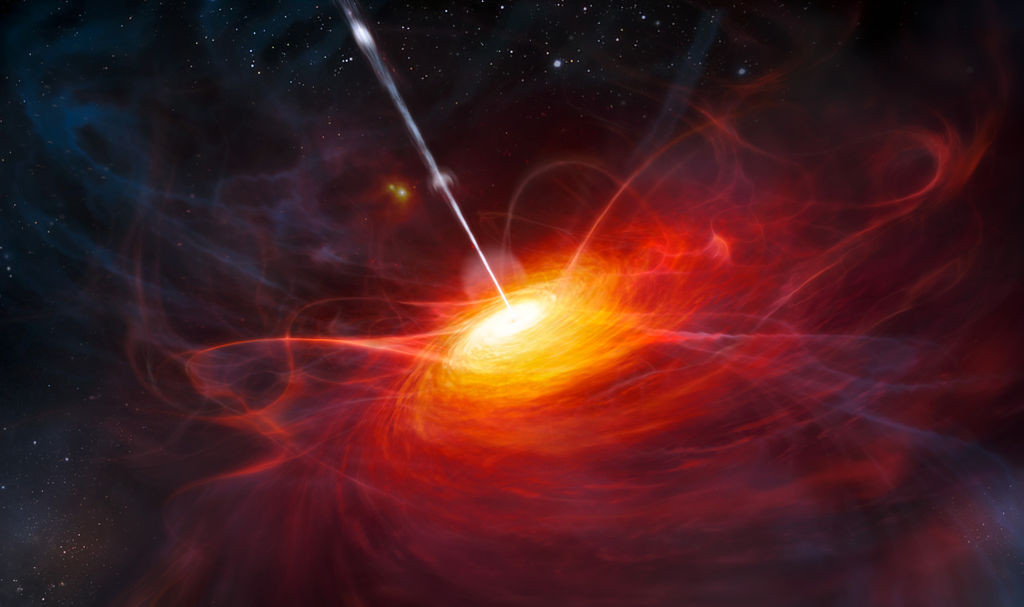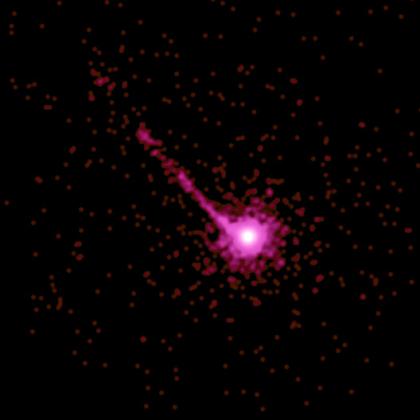
Artist’s rendering of ULAS J1120+0641, a very distant quasar powered by a black hole with a mass two billion times that of the Sun
On December 28, 1929, Dutch astronomer Maarten Schmidt was born. Schmidt is best known for measuring the distances of quasars. Quasars or quasi-stellar radio sources are the most energetic and distant members of a class of objects called active galactic nuclei (AGN). Quasars are extremely luminous and were first identified as being high redshift sources of electromagnetic energy, including radio waves and visible light, that appeared to be similar to stars, rather than extended sources similar to galaxies.
Early Years
Maarten Schmidt was born in Groningen, The Netherlands, and studied with famous astronomer Jan Hendrik Oort, one of the greatest astronomers of the 20th century, who made significant contributions to the understanding of the Milky Way and who was a pioneer in the field of radio astronomy.[1] Schmidt was educated at the universities of Groningen and Leiden. He earned his Ph.D. degree from Leiden Observatory in 1956 with a thesis on the mass distribution in the Galaxy [3], and was scientific officer of the Leiden Observatory until 1959, measuring stellar positions for the second Leiden expedition in Kenya. In 1959, he emigrated to the United States and went to work at the California Institute of Technology, where he joined the staff of the Hale Observatories (now Mount Wilson and Palomar observatories) as a Carnegie Fellow.

Maarten Schmidt (*1929)
In the beginning, he worked on theories about the mass distribution and dynamics of galaxies, which included the creation of a mathematical model of the Milky Way Galaxy based on all the available data concerning the distribution of the stars and interstellar gas and dust. Schmidt’s model led to greater understanding of the structure of the galaxy and its dynamical properties.[2] Of particular note from this period was his formulation of what has become known as the Schmidt law, which relates the density of interstellar gas to the rate of star formation occurring in that gas.
Quasars, the unusual Extragalactic Phenomena
He later began a study of the light spectra of radio sources. His most important achievement, however, was Schmidt’s study of an unusual extragalactic phenomenon, quasars, which he and other astronomers in the 1960s came to believe were exceptionally distant from Earth and were receding from Earth with a velocity greater than that of any other known celestial object.[2] In 1963, using the famous 200-inch reflector telescope at the Palomar Observatory, Schmidt identified the visible object corresponding to one of these radio sources, known as 3C 273 and also studied its spectrum. While its star-like appearance suggested it was relatively nearby, the spectrum of 3C 273 proved to have what was at the time a high redshift of 0.158, showing that it lay far beyond the Milky Way, and thus possessed an extraordinarily high luminosity. Schmidt termed 3C 273 a “quasi-stellar” object or quasar.

The Chandra X-ray image is of the quasar PKS 1127-145, a highly luminous source of X-rays and visible light about 10 billion light years from Earth.
At the Center of young Galaxies
Quasars show a very high redshift, which is an effect of the metric expansion of space between the quasar and the Earth. When the observed redshift of quasars is interpreted in terms of Hubble’s law, it is inferred that quasars are very distant objects. Quasars inhabit the very center of active, young galaxies, and are among the most luminous, powerful, and energetic objects known in the universe, emitting up to a thousand times the energy output of the Milky Way, which contains 200–400 billion stars. This radiation is emitted across the electromagnetic spectrum, almost uniformly, from X-rays to the far-infrared with a peak in the ultraviolet-optical bands, with some quasars also being strong sources of radio emission and of gamma-rays.
Explanations
Quasars are believed to be powered by accretion of material into supermassive black holes in the nuclei of distant galaxies, making these luminous versions of the general class of objects known as active galaxies. Since light cannot escape the black holes, the escaping energy is actually generated outside the event horizon by gravitational stresses and immense friction on the incoming material. Central masses of 105 to 109 solar masses have been measured in quasars by using reverberation mapping. Several dozen nearby large galaxies, with no sign of a quasar nucleus, have been shown to contain a similar central black hole in their nuclei, so it is thought that all large galaxies have one, but only a small fraction are active (with enough accretion to power radiation) and so are seen as quasars.
In early optical images, quasars appeared as point sources, indistinguishable from stars, except for their peculiar spectra. With infrared telescopes and the Hubble Space Telescope, the “host galaxies” surrounding the quasars have been detected in some cases. These galaxies are normally too dim to be seen against the glare of the quasar, except with special techniques.
Challenging previously accepted Theories
Schmidt’s discovery and interpretation of quasars challenged many previously accepted theories of the origin and age of the universe. In later years he joined teams finding x-ray and gamma ray sources from orbiting observatories such as ROSAT and the Compton Gamma Ray Observatory. He then obtained their optical spectra at the Keck Observatory. From 1978 to 1980 Schmidt was the last director of the Hale Observatories and supervised separating the administration of the Palomar and Mount Wilson Observatories. From 1984 to 1986 he was president of the American Astronomical Society, and from 1983 to 1995 he served on the board of the Association of Universities for Research in Astronomy, the last three years as chairman. Schmidt formally retired in 1996 but was still publishing as late as 2009.[3]
The term “quasar” was first used in a paper by Chinese-born U.S. astrophysicist Hong-Yee Chiu in May 1964, in Physics Today, to describe certain astronomically-puzzling objects:
“So far, the clumsily long name ‘quasi-stellar radio sources’ is used to describe these objects. Because the nature of these objects is entirely unknown, it is hard to prepare a short, appropriate nomenclature for them so that their essential properties are obvious from their name. For convenience, the abbreviated form ‘quasar’ will be used throughout this paper.”
Quasars are found over a very broad range of distances, and quasar discovery surveys have demonstrated that quasar activity was more common in the distant past. The peak epoch of quasar activity was approximately 10 billion years ago. As of 2017, the most distant known quasar is ULAS J1342+0928 at redshift z = 7.54; light observed from this quasar was emitted when the Universe was only 690 million years old. The supermassive black hole in this quasar, estimated at 800 million solar masses, is the most distant black hole identified to date.
Caroline Crawford, Quasars: the Brightest Black Hole, [7]
References and Further Reading:
- [1] Jan Hendrik Oort and the Oort Cloud, SciHi blog, April 28, 1015.
- [2] Maarten Schmidt at Britannica Online
- [3] Maarten Schmidt, at The Bruce Medalists
- [4] Maarten Schmidt at The Netherlands Institute
- [5] Mike Wall: 50-Year Cosmic Mystery: 10 Quasar Questions for Discoverer Maarten Schmidt, at space.com
- [6] Maarten Schmidt at Wikidata
- [7] Caroline Crawford, Quasars: the Brightest Black Hole, Gresham College @ youtube
- [8] Schmidt, Maarten (1959). “The Rate of Star Formation”. The Astrophysical Journal. 129: 243.
- [9] Timeline of Kavli Prize Laureates in Astrophysics, via DBpedia and Wikidata





